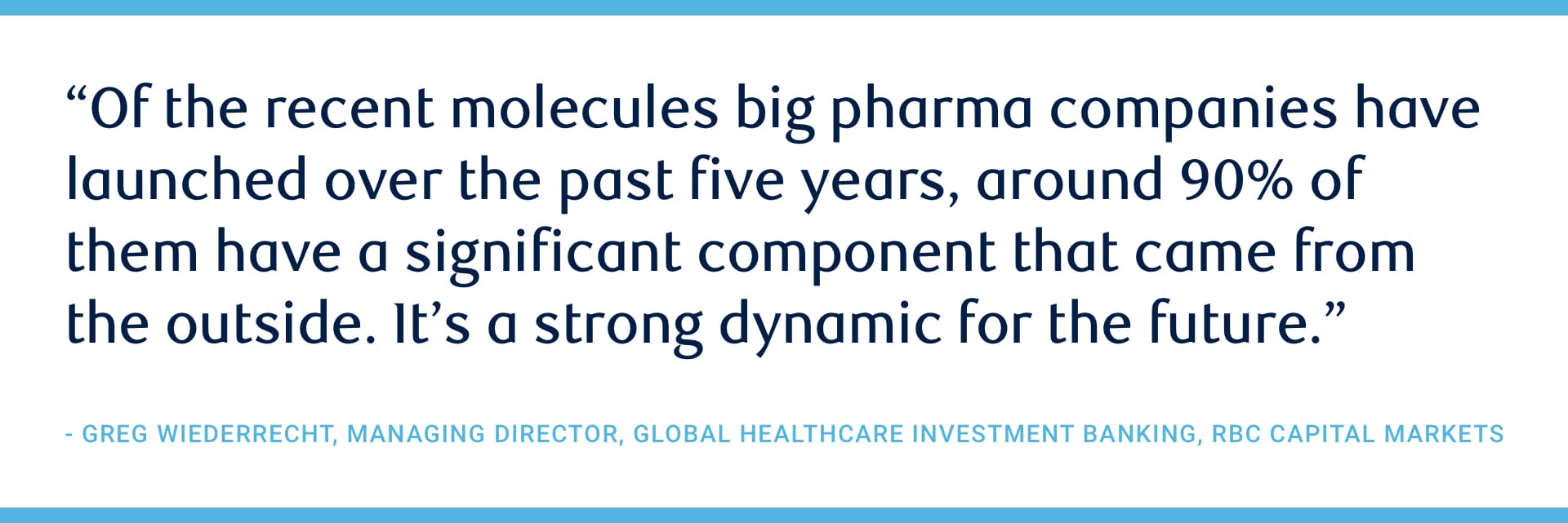
Biotech and Big Pharma: A blueprint for a successful partnership
Strategic partnerships have long been an important contributor to how drugs are discovered and developed. For decades, big pharma companies have been forming alliances with biotech innovators to increase R&D productivity, expand geographical reach and better manage late-stage commercialization costs.
Noël Brown, Managing Director and Head of Biotechnology Investment Banking, and Greg Wiederrecht, Ph.D., Managing Director in the Global Healthcare Investment Banking Group at RBC Capital Markets, are no strangers to the importance of these tie-ups. Noël has over 20 years of investment banking experience in the industry. Before moving to the banking world in 2015, Greg was the Vice President and Head of External Scientific Affairs (ESA) at Merck, where he was responsible for the scientific assessment of strategic partnership opportunities worldwide.
In the following Q&A, Greg shares his unique perspective on why partnerships are vital for both biotech and big pharma companies.
Noël Brown: Why are strategic partnerships appealing to both biotech and big pharma companies alike?
Greg Wiederrecht: “It’s a matter of scale. It’s impossible for large pharma companies to work in every single sub-therapeutic area out there. In today’s markets, the vast majority of approved drugs are associated with some type of licensing partnership or acquisition component. Even the largest companies can only work on so many targets at once, whereas there are hundreds of thousands of researchers in academia and biotechs out there who can specialize in vastly more diseases. If one of them makes a discovery that satisfies an unmet medical need, then large pharma can form a strategic partnership to provide a jump start on their competitors.”
NB: What exactly does a strategic partnership entail?
GW: “It can be something as minor as a feasibility study, or more significant like a patent license, development commercialization agreement, or even an acquisition. In fact, many acquisitions begin with a collaboration that went so well the pharma wants to acquire the biotech.”
NB: From a biotech company perspective, when is a strategic partnership the best path forward?
GW: “Strategic partnerships can be essential to a biotech for several reasons. A biotech may have a patent position on a novel target. However, it may not have the volume of preclinical development experts to get through what we call the ‘zone of chaos’ in drug development, which involves solving toxicity issues that can lead to unwanted surprises in clinical development.”
“Also, if a biotech is working on a project in a large-scale indication that afflicts hundreds of thousands of people, the clinical trial costs may be too much for them. Commercialization – particularly for those larger indications – is something big pharma excels in. They have infrastructures in most countries worldwide to sell the product.”
NB: With alliances increasing, what is it that makes some partnerships more interesting than others?
GW: “Big pharma tends to prefer first-in-class or best-in-class assets in areas of unmet medical need. They like to see a demonstration of target engagement in vivo. Pharma also likes novel chemical entity composition of matter patent protection, with a substantial patent protection runway.”
“They also like to see back-up molecules, so if the lead molecule fails, there’s a series of other molecules to fall back upon. Also, large pharma tends to prefer worldwide rights. And they don’t like indication splitting – that is licensing one indication for the molecule to one party and another indication for the same molecule to another party.”
NB: What does the actual strategic partnership process look like?
GW: “Generally, after an initial meeting with a biotech, large pharma will receive a non-confidential written dossier. That dossier is then pre-screened by someone in the evaluation group and, if deemed credible, passed on to a clinician for a deeper dive. After they’ve reviewed the dossier, a non-disclosure agreement will be signed, at which time the biotech sends a confidential dossier, followed by a face-to-face meeting with pharma subject matter experts.”
“If the opportunity is interesting, pharma will want to test the molecule, so you’ll execute a material transfer agreement for internal assays. Then there will be internal meetings with key executives to make decisions about whether to proceed to some type of a relationship.”
NB: With more and more biotech and large pharma companies working collaboratively, how have the dynamics of strategic partnerships changed over the last 10 years?
GW: “Many biotechs are much better financed than they were previously. There’s a whole new investor ecosystem out there looking to fund biotechs, so they’re no longer as desperate for financing as they once were. Also, the research tools that were once the domain of large pharma have largely been democratized.”
NB: What factors can improve the odds of a successful collaboration?
GW: “It’s important that big pharma recognizes the biotech is much smaller than they are. When a big pharma gets an asset from a biotech, the biotech executives will all have worked very hard – maybe exclusively – on that asset. So, it’s important the biotech sets up an agreement to ensure the pharma moves their molecule forward.”
“Pharma will often put a phrase into the contract to state that they are going to apply the same diligence to a biotech’s molecule that they would apply to their own. However, big pharma often puts its own molecules on the shelf when things aren’t working out. If it becomes really obvious that pharma is not applying the appropriate resources to your asset, you’ll want to be able to get your molecule back.”
NB: Given the changing dynamics in today’s industry, how will the strategic partnership landscape evolve in the years to come?
GW: “I see it continuing to evolve where biotechs do a lot of the discovery and pre-clinical development, with the quality of the science getting better all the time,”
“Big pharma is already evolving to be more focused on late-stage development and commercialization. Of the recent molecules big pharma companies have launched over the past five years, around 90% of them have a significant component that came from the outside. It’s a strong dynamic for the future.”

Gain perspectives from the cutting edge of biotech to help you lead today and define tomorrow. Explore RBC’s Pathfinders in Biopharma series.

